Content
It's hard to find someone who doesn't like chocolate or hazelnut candy. These small nuts not only taste good, but also have a beneficial effect on the human body.... The high content of vitamins, chemical elements and amino acids improves health in case of anemia, chronic fatigue, diabetes, neuroses and heart diseases. Hazelnut oil contained in nuts, supplying the body with vitamin E, restores vitality and has a rejuvenating effect. Eating hazelnuts in food is equally beneficial for children and older people. Let's take a closer look at this plant, with the features of the care and cultivation of hazel at home.
There is no industrial cultivation of hazelnuts in our country. Valuable fruits are imported mainly from Turkey, Italy, Spain and China. But hazelnuts are not as exotic as they seem. It is a cultivated form of common hazel, which grows under natural conditions in the Caucasus, the Middle East, Ukraine and throughout the European territory up to northern latitudes. So why not grow this unpretentious and useful plant in your dacha, because planting hazelnuts is an excellent business prospect and investment in your health.
Hazelnut - a cultural form of hazel on the site
Growing hazelnuts for a gardener won't be a big hassle. No wonder the Italians call "cultivated hazel" a plant for the lazy. Hazelnut is a shrub that reaches 2-5 m in height, depending on the variety, but can be formed by pruning in the form of a tree - the choice depends on the owner of the site.
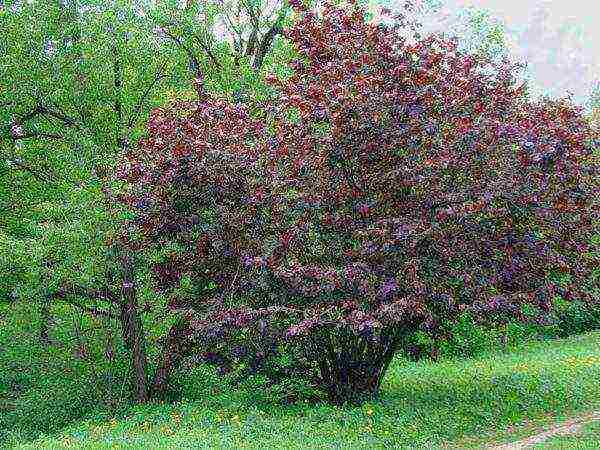 Hazelnuts can reach 5 m in height
Hazelnuts can reach 5 m in height
The first harvest can be expected as early as 3-4 years after planting the seedling... The plant does not need particularly careful care, because in natural conditions, hazel grows well without human help. After planting, agricultural technology is reduced to watering, removing root growth, annual pruning, and pest control if necessary.
Hazelnuts planted on the site for decades will supply fruits with high nutritional properties and useful substances. Mass harvesting of nuts begins from 5-7 years of plant life and lasts for 10-15 years... After that, the plant is "rejuvenated" - for several years in a row, 2-3 old branches are cut off, which are eventually replaced by young ones and begin to bear fruit generously.
From each adult hazelnut, subject to agrotechnical practices get 5-12 kg of fruitthat can be stored for a long time (1-3 years) without sacrificing taste. If you plant at least three plants on the site, the annual harvest will look quite significant.
Hazelnuts can grow in one place from 50 to 100 years. By planting a plant once, you will provide yourself and your children with valuable nuts for many years to come.
In addition to the benefits of harvesting, the plant has a high decorative effect. Hazelnut varieties have leaves of different colors and sizes., therefore, gardeners often practice planting variegated bushes in a row - with red, yellow and green foliage. Hazelnuts also look spectacular as a specimen plant, formed in the form of a tree. Aesthetic lovers will appreciate the beauty of the bush that throws out spectacular earrings that attract bees in early spring.
Reproduction of hazelnuts at home
Lovers of growing a tree from a nut may well resort to the seed method of reproduction. It is uncomplicated and, subject to the necessary requirements, will allow you to get a strong and healthy plant. However, such hazelnuts will begin to bear fruit much later than the one grown from a seedling. If, when planting a seedling, the first nuts appear 3-4 years after planting, then the plant grown
 Growing a hazelnut seedling from a nut
Growing a hazelnut seedling from a nut
from walnut, bears fruit for 6, or even 10 years.
Therefore, gardeners are more likely to use the planting of seedlings. With this method of reproduction, in contrast to planting a nut, all varietal characteristics of hazelnuts are preserved, based on which they choose a plant suitable for certain conditions.
Sapling selection
One- or two-year-old seedlings are selected for planting. It is recommended to give preference to winter-hardy and drought-resistant varieties.... The purchase of a seedling in a local nursery guarantees the receipt of zoned varieties adapted to the climatic conditions of the region.
When choosing hazelnut seedlings in a nursery or garden center, you need to carefully examine the root system of the plant. It should be well developed and free from damage. Slightly damaged roots are cut to a healthy place... If there is a lot of damage, you should refuse to buy a seedling, since a strong pruning can affect the survival rate and lead to the death of the plant.
Choosing a landing site
Hazelnut is considered a plant that is unpretentious to the composition of the soil and terrain. Moderately fertile soil and a sufficient amount of moisture are favorable for the development of the plant and future abundant fruiting. Most suitable for cultivation are gray forest soils, loamy, sandy loam and chernozems of various types. The optimal occurrence of groundwater is no closer than 1.2-1.5 m to the surface... During the spring thawing of snow, the site should not be flooded with water - prolonged waterlogging leads to decay and death of hazelnuts.
However, do not be upset for those whose soil composition on the site is far from ideal. Hazelnuts are safely grown on almost any type of soil characteristic of the middle lane, except for very heavy clayey, swampy, saline and dry sandy soils. When planting a seedling, chernozems are facilitated by the introduction of sand and compost humus - this will improve the air and moisture permeability of the soil... The composition of acidic soils is improved by the introduction of hydrated lime, ground chalk or wood ash.
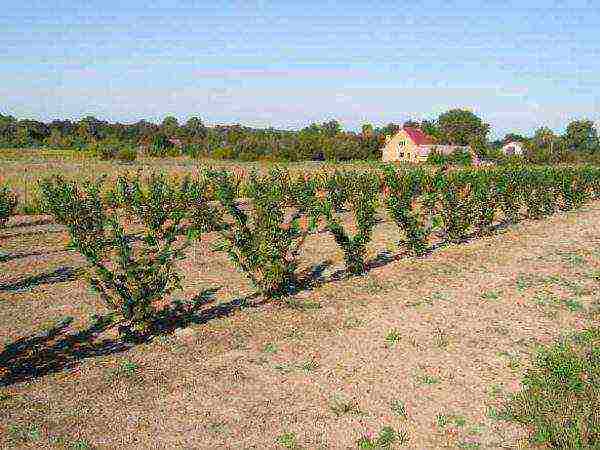 Planting hazelnuts is best done in autumn.
Planting hazelnuts is best done in autumn.
Hazelnuts grow equally well on flat areas and mountain slopes. Due to the developed fibrous root system, the plant is planted specifically in places where it is necessary to prevent soil erosion. When planting on a plot for hazelnuts, you can take any place that is not suitable for other horticultural crops.
Experienced gardeners practice in the first few years planting different garden crops between the bushes of young hazelnuts, which improve the composition of the soil, yield a harvest and do not allow empty space on the site.
An important requirement that must be observed when choosing a landing site is good illumination. Hazelnuts can grow in shaded areas, but then you should not hope for a good harvest.... Only the presence of a large amount of natural light contributes to abundant fruiting.
When planting on slopes for "cultured hazel", you can determine the place on any side except the south. It would seem that the south side is better lit and suitable for a plant that loves light. In fact, in early spring, in bright sunlight, flower buds bloom ahead of schedule, and then die during spring frosts.
The culture is sensitive to through winds, therefore when determining the site for planting, the areas that are maximally protected from drafts are selected... Walls of buildings or hedges are used as protection from the wind.
When planting several seedlings, the distance between them and to the nearest trees with a voluminous crown is maintained at least 4-5 m, depending on the size of the future plant in adulthood.
Landing technology
According to information from horticultural guides, seedlings of "cultivated hazel" can be planted in early spring (March-April) or in autumn. Hazelnuts have a short dormancy period, their buds move out earlier than other trees, and most of the plants planted in spring do not take root.
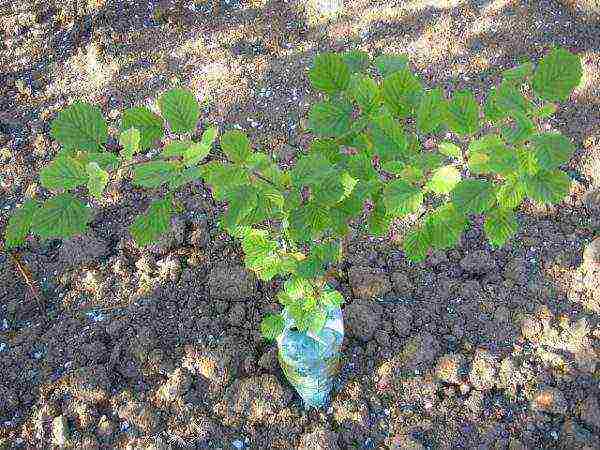 Hazelnut seedling Masterpiece
Hazelnut seedling Masterpiece
Experienced gardeners are more inclined towards autumn planting - in October-November. Dates for each area are determined individually, depending on weather conditions... In any case, the autumn planting is carried out a month before the onset of frost.
To get a generous harvest of nuts, at least three bushes of different inter-pollinated hazelnut varieties are planted on the site.
For autumn planting, a hazelnut planting pit is prepared since spring, if the planting of a seedling is planned for the spring, then the preparation is carried out in the fall. This technique allows the weed-free soil to rest and to accumulate a sufficient amount of moisture. Often, life makes adjustments to our plans, and if the decision to plant hazelnuts came spontaneously, the planting pit can be prepared at least two weeks before planting or immediately before planting.
The landing pit is dug 0.6 x 0.6 x 0.6 m in size. Organic and mineral fertilizers are introduced into the prepared pit and mixed well with the ground:
- humus - 2-3 buckets;
- double superphosphate - 150-200 g;
- potassium sulfate - 50-70 g.
Compliance with the recommendations for soil preparation will provide the seedling with sufficient nutrition for 3-4 years.
It is more convenient to plant hazelnuts with an assistant: one holds the plant and straightens the root system, the other carries out all the necessary manipulations. Planting technology is simple:
- If the roots of the seedling were processed in a clay mash, wash the clay from the roots... Dipping in a chatterbox is only necessary to retain moisture in the roots until the moment of planting.
- If the roots of the plant are a little dry, first put them in water for 1-2 days... Drying of the roots is evidenced by the shriveled bark of the shoots.
- If the roots are significantly dry, then not only them, but the entire seedling should be immersed in water for 1-2 days until the bark becomes smooth.
- Form a landing mound in the center of the pit, stick a peg into it.
- Place the seedling next to the peg, carefully spread the roots of the plant throughout the pit... The root collar of the seedling during planting should be slightly above the soil level. After watering, the ground will settle, and the root collar will be leveled to the ground. This is very important - when the root collar is buried in the ground, the hazelnuts will develop poorly, and they may not produce fruits at all.
- They fill up the hole in two passes... First, half of the hole is covered with soil, the earth is tamped a little and generously watered. Then the rest of the pit is poured, tamped again and watered again. The total amount of water for each seedling is at least 25 liters, optimally depending on weather conditions - 30-40 liters.
- Check the level of the root collar - maximum permissible excess above ground level is 1-3 cm.
- The seedling is tied to a peg and cut over 5-6 buds... The height of the aboveground part should be 20-25 cm. Pruning promotes the development of several fruitful shoots during the growing season.
Care of a young seedling
A near-stem circle with a radius of 0.5 m is mulched with peat, humus, manure or sawdust, leaving a free space of 5 cm near the stem. The mulch layer is usually 7-10 cm.
Hazelnut does not tolerate stagnant water, but at the same time it is a moisture-loving plant. Therefore, in the first time after planting, regular and abundant watering is of great importance for the growth of the seedling. The first time the plant is watered a week after planting, take a 7-10-day break and watered again. After that, you can be sure that the planting ball forms a single whole with the rest of the soil and will be able to retain the necessary moisture.
In the first 2-3 winters, hazelnut seedlings are covered with lutrasil or spunbond... This protects the plant from freezing and breaking out unripe shoots.
Further care and cultivation
From planting a seedling to the beginning of fruiting, depending on the variety, you will have to wait 3-4 years. The harvest will be small at first, but in 1-3 years, picking nuts will delight you with its abundance, and after 10 years it will be possible to collect a bucket of nuts from each bush. You can hope for abundant fruiting if the necessary measures for the care of hazelnuts are taken.
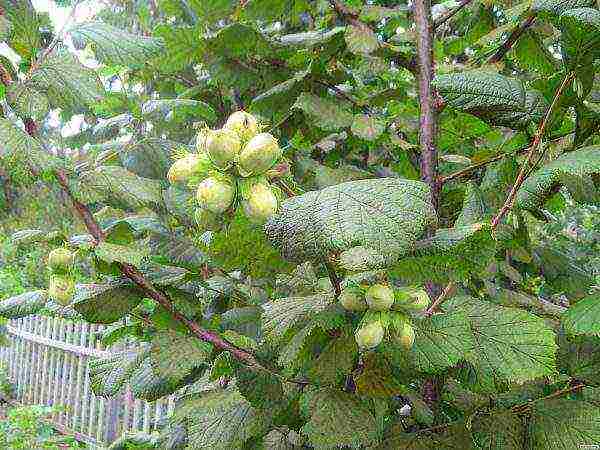 Green hazelnuts on the tree
Green hazelnuts on the tree
Watering
During the growing season, the plant is watered 1-2 times a month, the total number of waterings since April is 5-6 times... The last time the shrub is watered after the fall of leaves - this will create a charge of moisture necessary for the plant in the soil for the next spring. In June and July, the need for moisture increases due to the growth of fruits and the laying of the generative organs of the harvest of the next season, therefore, hazelnuts are watered twice during these months. For irrigation, use 40-50 liters of warm water for each bush.
Weeding and mulching
Weeding helps to kill weeds and to saturate the root system with air. When loosening the soil, it must be borne in mind that most of the roots come close to the surface. Damaged hazelnut roots are not restored, so the depth of weeding is 8-10 cm... The soil of the trunks is mulched with peat, sawdust, and dry grass.
Pruning
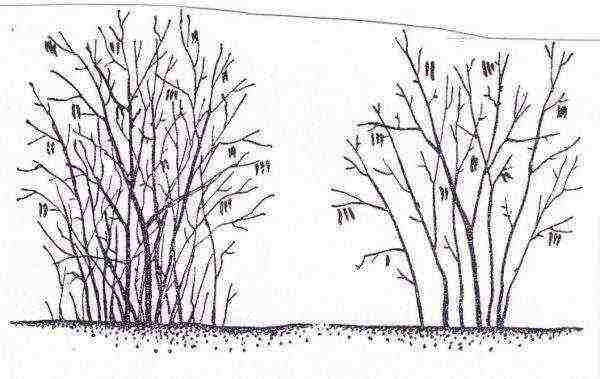 Hazelnut pruning scheme: on the left - before pruning, on the right - after pruning
Hazelnut pruning scheme: on the left - before pruning, on the right - after pruning
Pruning is necessary to form the shrub. During each summer season, extra shoots are cut, leaving 8-10 of the strongest... They try to remove shoots located inside the bush, as well as weak and damaged ones.
Hazel pest control
For hazelnuts from pests, hazel weevil and hazel barbel are dangerous. Signs of their appearance are "worminess" and premature drying of the fruit. Insect control uses systemic insecticides, carrying out processing in early May, when the beetles appear in large quantities, and in mid-June, when the nuts protrude from the plyuska. Of the diseases, powdery mildew is most often found, which can be eliminated by treatment with colloidal sulfur, lime-sulfur broth or store-bought fungicidal agents, as well as timely cleaning of infected fruits and fallen leaves.
The reader may get the deceptive impression that planting and growing hazelnuts is a rather troublesome task. In this article, we tried to give as much information as possible useful for owners of summer cottages and their own estates. Hazelnuts do not need a special temperature regime, they can grow on almost any soil and withstand the lack of dressing... It is enough to make a minimum of effort, and the plant will thank you with a generous harvest of tasty and healthy nuts.
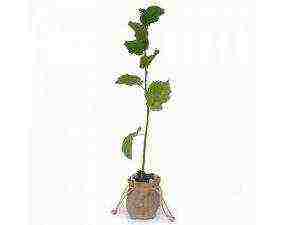 Varieties
Varieties
Hazelnuts have many varieties; they are cultivated hazelnuts. Numerous experiments eventually made it possible to breed hazelnut varieties that are very fertile and resistant to difficult weather conditions.
Some of them are used industrially, others have excellent decorative properties. Most importantly, you can now grow your own hazelnuts.
But first you need to decide what kind of variety you want to see on your site.
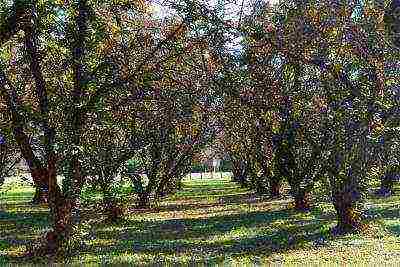 Hazelnut
Hazelnut
This hazel is presented in the form of a branchy shrub, the height of which can be from 1.5 to 5 m. Occasionally, you can find trees, the height of which reaches 7 m.
The flowering period is February-April. The time depends on the place where the nut grows. In the southern regions, the flowering period begins towards the end of January. It occurs before the leaves bloom. Often only one seed develops, although the ovary includes two ovules.
The fruit is a drupe in a plyus. The fruits are cylindrical, but sometimes there are round-ovate and flattened drupes. When ripe, the shell becomes intensely brown, the nut falls out of the plyus.
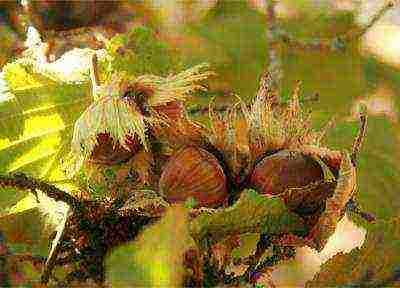
Grows mainly in oak and mixed forests.
The life span of a hazelnut is no more than 80 years. From one hectare, the yield is from 500 kg. up to 2.5 tons. Wild hazelnuts have become the basis for the cultivation of new varieties for industrial use.
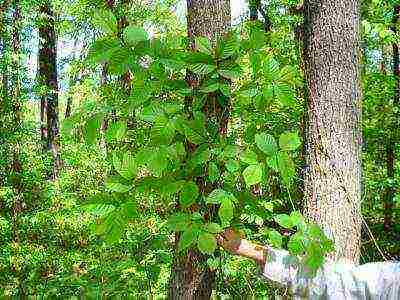 Red-leaved
Red-leaved
Red-leaved hazelnut bushes are the common name for a whole array of varieties. Their distinctive feature is the dark red foliage, which can turn green only in autumn.
Such shrubs not only serve as a way to obtain nuts, but also play an important decorative role. A red-leaved hazelnut hedge will give the site an excellent appearance. In addition, bees love it very much, and therefore the presence of bushes near the apiary will allow you to get good honey.
Of the currently useful varieties of red-leaved hazelnuts, the following can be distinguished:
- Catherine,
- Academician Yablokov,
- Smolin,
- Kudrife,
- Moscow ruby.
A characteristic feature is increased frost resistance. The work of the students of Academician Michurin made it possible to obtain varieties that are excellently grown in the middle lane on the territory of Russia, easily tolerate severe winters and give a bountiful harvest of large nuts. He is not whimsical even in relation to the soil. But they require abundant watering after planting.
Trebizond
The most famous hazelnuts bred in Ukraine. For the first time hazel appeared on the territory of Crimea 500 years ago and is most widespread here.
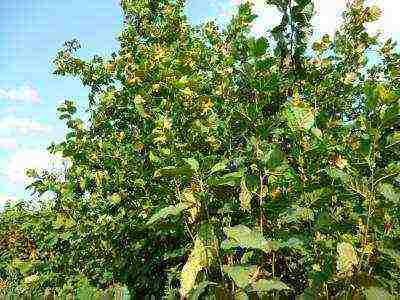
Has a number of characteristic features such as:
- Large size;
- Fat content - 72%;
- Output core - 60%;
- For 100 nuts in shell, about 500 grams is obtained. product;
- Resistant to frost up to 32 ° below zero;
- Ripens in the second decade of August;
- It is the largest hazelnut species in the world;
- Incredibly prized in the industry, but rare at this level;
- Belongs to the highest grade according to state standards.
Other varieties
In addition to the named varieties, there are many more varieties of hazelnuts that are recommended to grow. These include:
- Circassian;
- Curly;
- Kerasund;
- Palace;
- Badem;
- Lombard;
- Barcelona;
- Ata Baba;
- Yagly;
- Panachessky;
- Galsky;
- Cadetten, etc.
Growing at home
This nut is prized as a shrub for growing seedlings, which are then sold. Or you can grow bushes and collect fruits on your own plot, which is also very useful and tasty.
For all the features of planting hazelnuts, see the program "6 acres".
From nuts
Hazel or hazelnut can be propagated using the nuts themselves. Quite often, such seedlings turn out to be even better in terms of quality than the "parents".
As for hybrid varieties, they are grown exclusively by layering - horizontal or arc. A vegetative method is used, which allows you to preserve the characteristics and characteristics of the hazelnut variety. It is almost impossible to preserve them when planting with seeds.
Occasionally, the vaccination method can be used. However, it is not always relevant, since the branches are delicate and the cambium layer is thin.
If you are sowing indoors, then in December you need to lay nuts for germination for stratification. It lasts a month and a half. The seeds are placed in a container filled with sand and sent to the refrigerator. You can also use a snow cushion or a basement with no heating.
After that, the nuts are taken out and planted in containers, inside which there is soil with sand. The sand layer should be about 25-40 millimeters. Covered with polyethylene.
As soon as the sprouts appear, constant water pollination should be started and looked after as a simple seedling. It is necessary to transplant prepared seedlings to a permanent place in greenhouses in June.
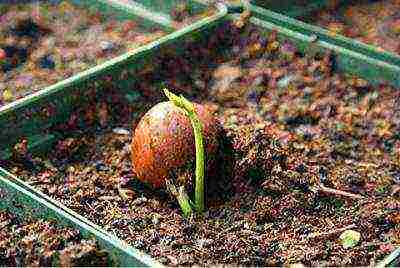 Saplings
Saplings
Growing seedlings on your own is a rather long and difficult procedure. In addition, they can be found on the market without any problems. But in order to choose the right option, you need to know a few simple rules:
- Root system. It should be well developed, plus see that there is no dryness.
- In no case damage is allowed on the shoots.
- Pay attention to the kidneys. If they have already blossomed and turned into leaves, it is better not to take such seedlings. Give preference to nodding or dormant kidneys.
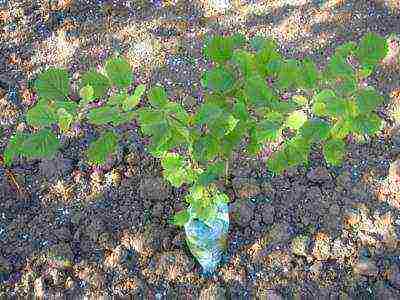 Landing
Landing
Before proceeding directly to planting, you should correctly choose a place for this. There are several features worth paying attention to:
- The site must be flat, but small slopes up to 10 degrees are also allowed;
- If the slope is greater, then they must be traced, as well as equip the corresponding holes;
- Choose direction north, west or east. The southern ones are too dry, therefore they are not suitable. Because of this, hazelnuts can suffer from frost and premature flowering;
- Choose a location that has protection from the cold winter wind. Desirable natural - other plantings, trees, etc.;
- Suitable for growing black soil, gray forest bud. Do not use saline, waterlogged and dry sandy soils;
- Most of all known varieties of walnuts are very fond of moisture, so the yield will largely depend on the intensity of watering.
Landing rules
- When choosing a vegetative propagation method, divide the planting materials into ordinary seedlings, non-standard and suitable for planting. Non-standard ones are planted in the school, where they grow up.
- Seedlings, cuttings and rhizomes are planted in schools. In this case, the inter-row spacing is 90-120 centimeters, and in rows - 20-30 centimeters each.
- The optimal time for disembarkation is autumn, about a month before the cold snap begins. This will allow the root system to recover by spring, just in time for the beginning of the growing season.
- Finished seedlings should be placed approximately 4-5 meters apart. Placement method - squares or chess principle. If the site has a steep slope, then use only a checkerboard pattern.
- In the planting hole, add about 5 kilograms of humus, about 50 grams of potassium salt, and superphosphate - about 100 grams.
- If the soil is poor enough, the specified amount of fertilizer is doubled. Then the seedlings need to be watered and mulched abundantly.
For the cultivation of hazelnuts on an industrial scale, see the following video.
Care
It is not enough just to plant and water the hazelnuts after planting. Now he will need careful care.
Care includes a number of activities:
- Hazelnuts will take a lot of nutrients from the soil, which means that fertilizers must be added annually so that the yield does not fall.
- Compost and manure are the best fertilizers that have everything a nut needs. They need to be brought in under deep digging. If there is little organic matter, then potash and phosphorus fertilizers can be used.
- Nitrogen additives dissolve very easily, therefore it is recommended to use them when leaving in early spring. Nitrogen plays a very important role in the early growing season.
- Nitrogen fertilizers, as well as phosphorus supplements, are used every year, while potash fertilizers can be added only once every two years.
- During the growing season, the soil must be loosened several times, weeds must be removed. The trunk circle does not loosen deeply - no more than 8 centimeters. This is due to the risk of damaging the roots located at a depth of only 10-15 centimeters.
- Be sure to treat shrubs from pests. They are not very dangerous, but you shouldn't risk it. The first treatment is carried out after the end of flowering, and the second - when the size of the nuts is approximately equal to the size of the peas.

Foreword
To collect large and tasty hazelnuts from your site, you should plant seedlings in the correct way, regularly prune, rejuvenate plants, water and feed. Learn all the intricacies of growing hazelnuts and put them into practice to get a good harvest!
We lay a hazelnut garden
It is best to grow hazelnuts at home on highly fertile soils, well provided with moisture.
Still, hazelnuts are not too picky about the quality of the soil and can grow in sandy stones and calcareous soils. Do not plant hazelnut bushes in soil depressions where moisture accumulates, in wetlands, in places with high groundwater. It is also not recommended to plant hazelnut gardens on the southern slopes of the hills, since early warming up by the sun's rays will stimulate the premature release of flowers, which will subsequently undergo hypothermia from returned frosts and from such damage, fruits will not be able to form.
The solution to the question of how to grow hazelnuts should begin with the selection of the planting time and soil preparation. It is rational to lay a hazelnut garden in the fall, since due to a short dormancy period, spring plantings of this plant often do not take root in a new place. For autumn plantings, the soil should be prepared in spring. A rather deep plowing is carried out - the earth is loosened to a depth of 30-40 centimeters, which helps the root systems to settle freely for permanent residence and helps to provide them with an increased flow of air and water, which is very significant at the initial stages of growth.
After plowing, the land remains free all summer, under fallow. This promotes the accumulation of water. Digging holes for seedlings is carried out about a month and a half before planting. Their depth and side edges should be 50-70 cm. If it was decided to plant hazelnuts in spring, plowing should be carried out in the fall, and then dig holes.
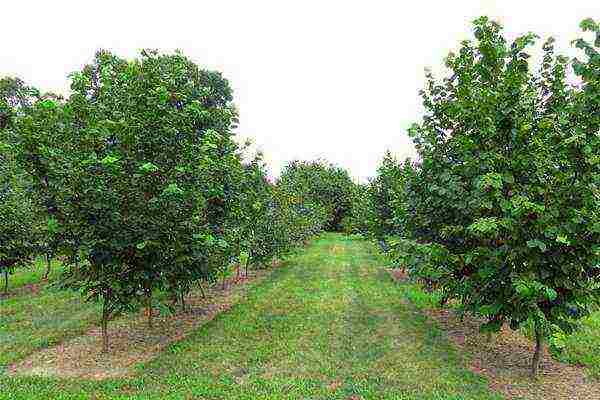
It is more convenient to plant hazelnuts together. One person covers the soil, and the second holds the seedling and distributes the root system in the hole, preventing its compaction. Do not bury a young bush too deep. The root collar of developed plants should be left at surface level, and weakened ones should be dug in by 5 cm.
Immediately after planting, hazelnut seedlings are cut off, leaving only 20-30 centimeters from the ground. Each plant is watered abundantly, using 25-30 liters per bush. To help the hazelnuts take root well, mulch the soil around them, that is, overlay them with dry vegetation to prevent rapid drying.
The hazelnut planting scheme should be as follows: the distance between the rows is left within 5-7 meters, and a gap of 4-5 meters is made between the plants in the row. The more fertile the soil, the more space you need to allocate for a separate bush.
How to grow hazelnuts in the country
To obtain a harvest of hazelnuts, care must be taken that the flowers of the plants are pollinated. After all, hazelnut bushes are monoecious (divided into male and female). Therefore, a good male should be planted in the vicinity of fertile female plants. For these purposes, it is often recommended to take "savages" - hazel, growing well without much care.
In a flourishing state, you can immediately understand where the "men" and where the "women" are. The former form catkins, and the latter create rounded buds with red stigmas protruding from them. The hazel is planted one at a time in 10 rows of hazelnuts. Planting different varieties of hazelnuts in the garden contributes to an increase in the yield and the formation of especially large fruits. For this, 3-4 varieties of nuts are used, planted in groups of 3-4 rows.
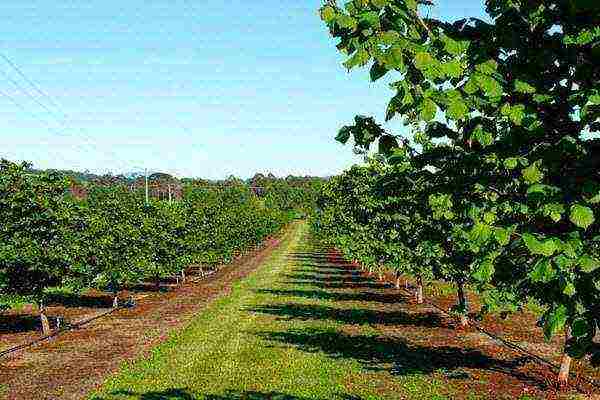
Hazelnut bushes should be trimmed regularly, and this will directly affect the quantity and quality of nuts obtained from them. In the second or third year after planting, when the plants will give abundant growth, it should be seriously thinned out by removing all branches except 8-10.These ten will become the main trunks of the crown, so you need to choose visually powerful ones, located at a sufficient distance from each other.
After pruning, the bush will begin to take the shape of a vase, and gardeners will have to monitor its internal density, which should not be excessive. The thickening of the hazelnut plant leads to a deterioration in the quality of the nuts - they will be small and the overall yield will also decrease. Reducing the density of the bush is the main purpose of pruning and after the start of fruiting, which happens in 3-5 years of plant life.
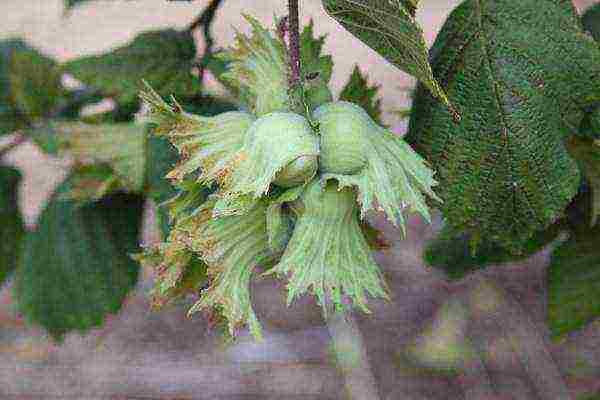
It should be remembered that the main ten trunks of the bush must be replaced regularly. They age over time and stop growing, begin to produce few nuts. Every five years, old trunks are trimmed and young shoots are left in their place. Rejuvenation of hazelnuts is necessary to increase the effective life of the plant. Without it, the bushes will no longer bear fruit normally after 25 years. And with thoughtful care, one plant will feed people with nuts for 150-180 years.
Regular circumcisions are performed during the hibernation period before the release of the buds and the beginning of the growing season. In this process, you also need to pay attention to the removal of dried and broken branches.
In addition, it is important to prune the root growth. If you do not devote time and effort to it, the hazelnut bush will spray its energy into many alternative trunks and will not be able to grow good nuts. Root shoots are removed at the very beginning of its formation, until it reaches 5-6 centimeters in height. Moreover, it is necessary to cut off not only what has broken through to the surface, but also the sprout hiding in the ground. It is necessary to carefully remove the soil and cut off the growth at its very base with a pruner, trying not to damage the roots.
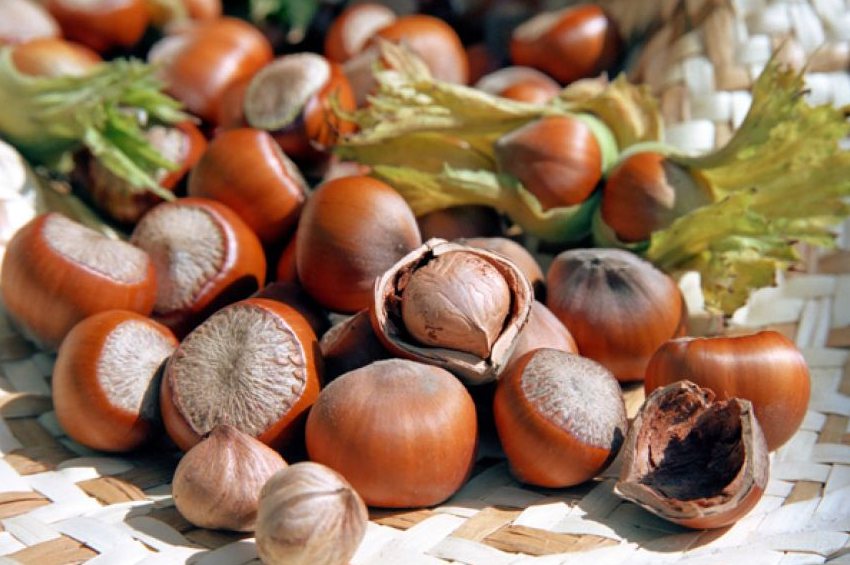
Watering, fertilizing and pest control
Hazelnuts are a moisture-loving plant and if the weather is dry for a long time, your garden should be watered abundantly. About 40 liters of water is poured under each bush. Naturally, this is done gradually so that moisture is absorbed into the soil, and not spilled over the surroundings. As with planting seedlings, during drought, dry vegetation should be spread around hazelnut bushes to reduce evaporation from the soil.
Mulching trees should be done carefully, trying to leave a gap between the laid out grass and the trunk of the plant so that high humidity and putrefactive processes do not damage the bark. Even in the absence of drought, attention should be paid to watering. Many gardeners recommend pouring hazelnuts 3-4 times during the growing season.
If you want to get a large hazelnut, grow it with fertilizers! For these purposes, manure is well suited, which is applied in proportions of 3-4 kg per square meter. From mineral fertilizers, you can add 50 grams of superphosphate, 50 grams of ammonium nitrate, 10 grams of potassium sulfate to manure. The mixture is added to the soil during autumn digging. During the growing season, 10 grams of ammonium nitrate is applied twice: in April and early June. Top dressing of hazelnuts is carried out after rain or watering.
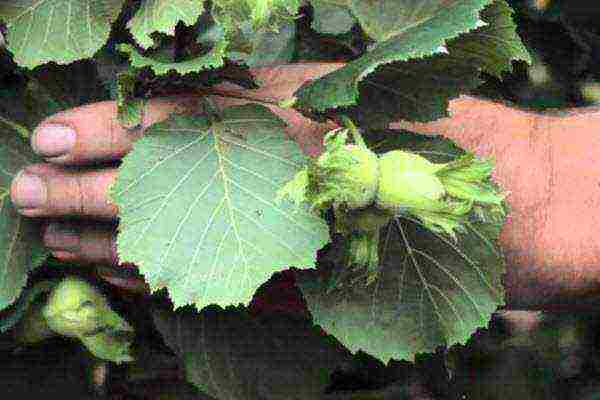
Hazelnuts are quite resistant to diseases and pests, but they can be attacked by nut weevil and nut barbel. Deep digging and cleaning of worm nuts will protect against weevil. In extreme cases, you can resort to spraying with a solution of 0.4% "thiophenite 20". The same drug helps in the fight against barbel. The shoots captured by them are removed and burned. Powdery mildew is isolated from hazelnut diseases. The leaves affected by it are collected and burned, and the bushes are sprayed with lime-sulfuric broth at a concentration of 2%.
Hazelnuts are easy to grow in the garden! And with just a little effort, you will get a really excellent nut harvest!
.
Many people love hazelnut chocolate. This hazel not only tastes good, but also has a positive effect on metabolism. It is good for both adults and children to eat hazel.In the modern world, many people grow nuts on their own, most often they use ready-made seedlings. But few people know how to grow hazelnuts from walnuts.
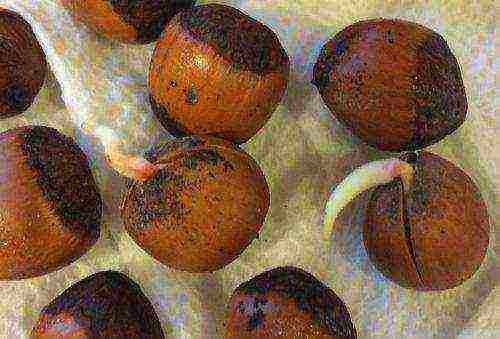
Hazelnuts can be grown independently from a nut
Hazelnut characteristics
Hazelnuts are shrubs, but an adult crop can reach a height of 5 meters, depending on the variety. Easily adapts to any habitat.
The tree gives its first harvest at the age of 3 years, but this is only if ready-made seedlings are planted. If the plant is planted with seeds, then the first fruits will appear only after five years. The main advantage of hazelnuts is that they do not need any special care. It is jokingly called the tree for the lazy. How to care for hazelnuts:
- watering;
- prune every year;
- remove overgrowth;
- fight pests if they appear.
The culture will delight its owner with fruits for several decades. Massive fruits appear on the plant after the fifth year of life. After 20 years, in place of the old shrub, you need to plant a new one or rejuvenate by removing old branches, because hazelnuts can grow in one place for 50 years.
From a tree that has begun to bear fruit in large quantities, you can get from 5 to 12 kilograms of hazelnuts per season, so if you grow hazelnuts for sale, you can get a good profit. The fruits can be stored for up to three years.

The hazelnut tree needs rejuvenation every 20 years
Reproduction of a crop using seeds
Self-grown hazelnuts are the pride of any gardener. Many are interested in how to grow hazelnuts from walnuts at home. One of the ways is seed. If you follow all the rules for planting and growing, you can get a good, healthy tree. Growing hazelnuts in this way will take a little longer than planting from seedlings.
After planting the seeds, the first fruits are in the sixth year of the shrub's life, and sometimes only in the tenth, so experienced gardeners often acquire ready-made seedlings. But if you are willing to wait, then you can use the seed method of reproduction.
When preparing a seedling, there are rules: the fruits of the hazelnuts must be whole and unaffected by pests. The seeds are placed in water or sprinkled with wet sand. Leave the fruits in this state for several days. The hazelnuts must germinate, after which they are transplanted into a pot. In such containers, seedlings grow for two years, after which they can be transplanted into the ground.

For planting, you should select the best hazelnuts
Place for planting hazelnuts
Planting hazelnuts does not require special soil. This plant is not whimsical and can be easily rehabilitated in any area. The best place to plant it is soil with the right amount of moisture. But if there is none, then it needs to be watered often. The shrub is very fond of these soils:
- forest gray;
- loamy;
- sandy loam;
- black soil.
Groundwater flowing near the planting site will have a positive effect on the growth and fruiting of the shrub. It is advisable to choose a place where the accumulation of water will not be large in spring, otherwise the roots of the plant will rot.
The main condition that you need to pay attention to when landing is lighting. The culture can grow in the shade, but this will reduce the yield: the abundant fruiting of hazelnuts depends on the amount of light.
Before sowing, it is advisable to choose a place where there is no draft, since it can provoke various diseases or the death of a shrub. If there is no closed area, then it is necessary to create appropriate conditions. To do this, you can make a slate fence.
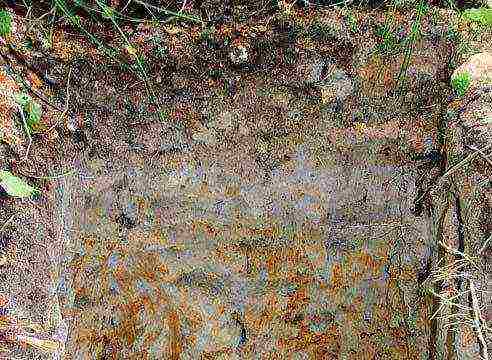
Sandy and loamy soils are optimal for hazelnuts
Planting rules
Research the technology before planting a hazelnut. If you have succeeded in growing a seedling from a fruit, this is a good sign. Planting of planting material is carried out in the spring or autumn.Hazelnuts have a short dormancy period, so they begin to release their first buds before other crops.
Because of this, gardeners do not recommend planting shrubs in the spring, since very few seedlings take root during this period.
How to plant hazelnuts:
- Prepare a pit measuring 0.6x0.6x0.6 meters.
- Apply fertilizer.
- Clean the roots from clay talkers, and if they are dry, then place them in water for several days.
- In the center of the hole, make a hump and place a seedling there.
- Cover with earth so that a small depression remains in the pit for irrigation.
It is necessary to fill up the hole in several approaches. For the first time, fill in half and pour with water. When all the water is absorbed and the earth is compacted, fill up the second batch and fill it with water again. One young shrub requires about 25 liters of water for planting.
After planting, the hazelnuts are tied to pegs and regularly cut over five buds. The aerial part of the plant should be 25 centimeters. Constant pruning speeds up the development of fruitful shoots.
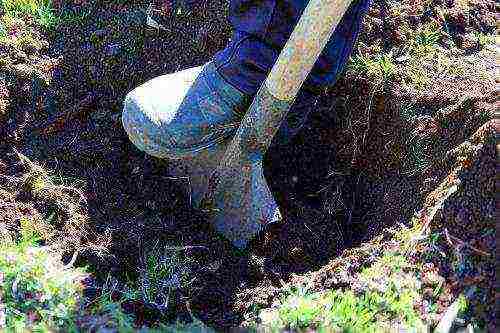
The pit for planting hazelnuts should measure 0.6x0.6 meters
How to care for walnut seedlings
A young seedling must be fertilized regularly. You can use humus, manure or sawdust. Fertilizer will accelerate its growth and promote the emergence of fruitful shoots.
Hazelnuts are very fond of moisture, but its stagnation negatively affects its normal development, therefore, in the first time after planting, the shrub should be watered regularly, but in moderation. The first watering is carried out exactly seven days later, after 1-2 times a week. This will allow the planting soil to merge with the rest of the soil. Only in this way will the culture be able to retain all the necessary moisture.
For the first few years, seedlings are sheltered from frost with the help of lutrasil or spunbond. This will allow the hazelnuts to survive the winter successfully.
It is necessary to regularly inspect the culture for the presence of pests. Parasites are very fond of young trees, they destroy them quite quickly, so it is recommended to regularly process the tree from a variety of pests.
Subscribe Be aware of new products on our site


